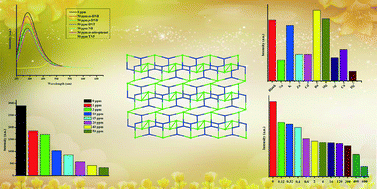A fluorescent sensor for highly selective sensing of nitro explosives and Hg(ii) ions based on a 3D porous layer metal–organic framework†
Abstract
A 3D porous layer metal–organic framework, namely [Cd(BPDC)0.5(L1)(NO3)]·3.4DMF (1), was synthesized under solvothermal conditions. The structure was characterized by single crystal X-ray diffraction analysis, powder X-ray diffraction (PXRD) analysis, thermogravimetric analysis (TGA), infrared spectrophotometry analysis and elemental analysis. The structure of 1 displays a 3D porous layer and can be classified as a (3,4)-connected topology with a point symbol of (42·6·38)2(42·6). The framework is stable to a certain degree. 1 can also be applied as a fluorescent sensor for small-molecule sensing, such as nitrobenzene (NB) and 2,4,6-trinitrophenol (TNP). In addition, 1 is a rare example of MOF-based fluorescent probes targeting environmentally relevant guest species, such as Hg(II) ions in aqueous solution, with high selectivity and sensitivity.


 Please wait while we load your content...
Please wait while we load your content...